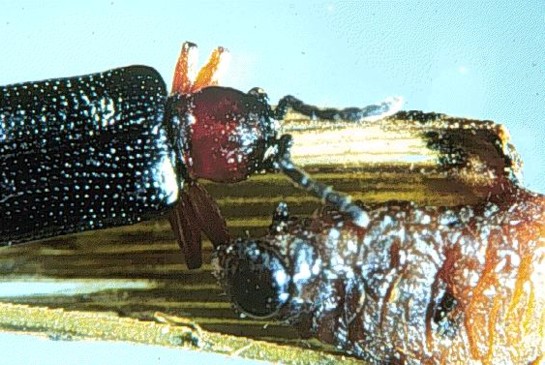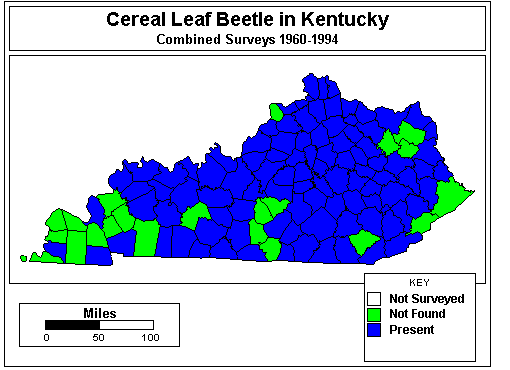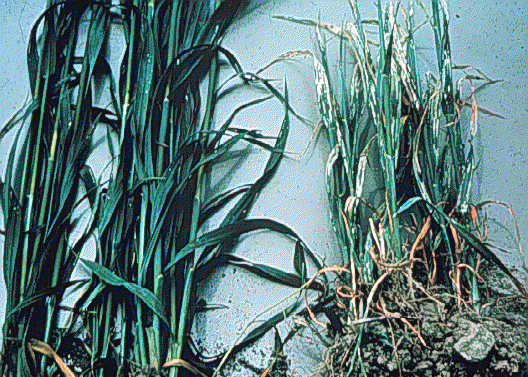Cereal Leaf Beetle in Kentucky Wheat
ENTFACT-107: Cereal Leaf Beetle in Kentucky Wheat | Download PDF
by Doug Johnson, Extension Entomologist
University of Kentucky College of Agriculture
Cereal leaf beetle (pictured below) is a widely distributed pest of small grains in Europe and the Middle East. In 1962 it was discovered in Berrien County, Michigan, and has been spreading through the eastern small grain producing areas of the US ever since. During the mid 1980's this pest was observed feeding in wheat in the south central areas of Kentucky. Since that time it has moved steadily westward. It is now generally distributed (see map below) throughout the major wheat producing areas of the state all the way to the Mississippi River. The major area of impact is usually in the southern Kentucky counties from Wayne County to the Cumberland River.


This pest will occur from about mid-April until wheat maturity. The beetles over-winter as adults, and re-enter fields when warm-up occurs. After mating, females deposit small clusters of eggs usually on the upper surface of the leaf. These eggs are bright yellow just after they are laid but darken to almost black, just before hatch. They are shaped like cylinders with rounded ends.

The larvae (pictured above) are pale yellow in body with a brown-black head and legs and may appear wet or shiny. However, because of their habit of covering themselves with pieces of feces and plant material they appear more like bird droppings.
After the larvae are full grown they will drop off the plants and pupate in earthen cells, usually in the top 2 inches of soil. In about 20-25 days adults will emerge from the cells. The entire life cycle takes about 46 days.
Perhaps the easiest way to detect CLB is through their damage. Both the adults and the larvae remove the upper surface of the leaf in long narrow strips between leaf veins. This feeding pattern leaves long whitish scars on the leaves, and is very indicative of CLB.
CLB Damage
Cereal leaf beetles are the food source for a number of parasites and predators. CLB eggs are eaten by lady beetles and several wasp parasites prey on the larvae. Additionally, a fungal disease also reduces the populations. As a result the presence of CLB in a field does not necessarily mean that economic populations exist. In general, populations must reach at least one adult or larvae per head bearing stem before control is required, and this is a very conservative threshold.
To determine if a CLB population has reached the economic threshold examine ten plants per location in about 1 location for every 10 acres of field size. Locations should be spread out and reflect the nature of the field. Do not pick particularly bad or good areas and avoid field edges. Count the number of CLB per stem and, if on average, the population exceeds 1 per stem a control may be required.
Insecticidal control of CLB is not particularly difficult. Any of the insecticides listed in ENT-47, "Insecticide Recommendations of Small Grains", should do an adequate job.
Revised: 11/93
CAUTION! Pesticide recommendations in this publication are registered for use in Kentucky, USA ONLY! The use of some products may not be legal in your state or country. Please check with your local county agent or regulatory official before using any pesticide mentioned in this publication.
Of course, ALWAYS READ AND FOLLOW LABEL DIRECTIONS FOR SAFE USE OF ANY PESTICIDE!
Photos University of Kentucky Entomology

